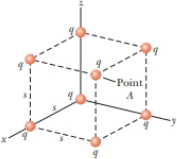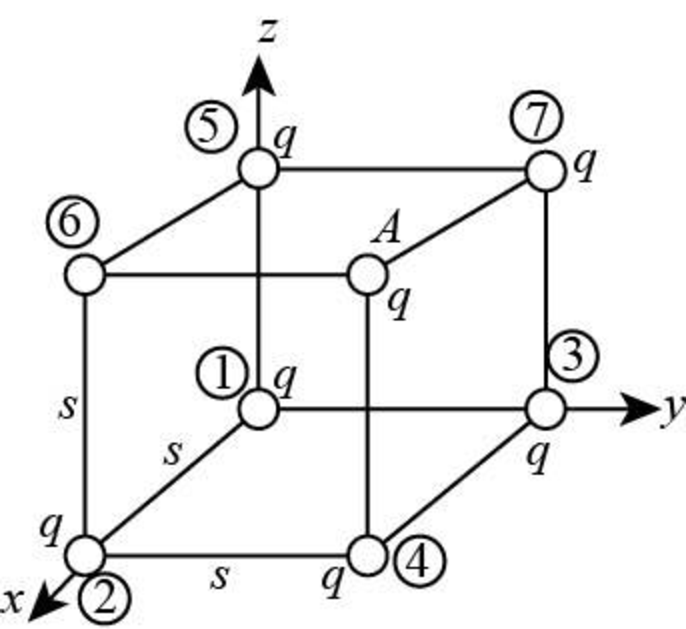
Concept explainers
Eight charged panicles, each of magnitude q, are located on the corners of a cube of edge s as shown in Figure P22.48. (a) Determine the x, y, and z components of the total force exerted by the other charges on the charge located at point A. What are (b) the magnitude and (c) the direction of this total force?
Figure P22.48

(a)
The
Answer to Problem 23.85CP
The
Explanation of Solution
The side of the each cube is
Write the expression for the coulomb’s force law between the two charges
Here,
The charge configuration is as shown in figure below.

Figure (1)
The charges present at the sides are distance
For the net force in
For force due to charge 6 is only in the y-direction
Substitute
The force due to charge 5 and 2 makes an angle
Substitute
Substitute
The charge 1 is
Write the expression for the cosine value of the angle
Write the expression for the force due to charge 1
Substitute
Substitute
Write the expression for the net force in
Substitute
Thus, net force in
From the cubical symmetry the net force in
Thus, net force in
And the net force in
Conclusion:
Therefore, the
(b)
The magnitude of the net force.
Answer to Problem 23.85CP
The magnitude of the net force is
Explanation of Solution
The side of the each cube is
Write the expression for the magnitude of the net force
Substitute
Conclusion:
Therefore, the magnitude of the net force is
(c)
The direction of the net force.
Answer to Problem 23.85CP
The direction of the net force is away from the origin.
Explanation of Solution
There is a force component in
Hence, the net force isn’t along any particular direction rather it has components in all three directions with equal magnitudes and it is pointed away from the origin
Conclusion:
Therefore, the net direction is away from the origin making equal angle with all the three axes.
Want to see more full solutions like this?
Chapter 23 Solutions
Physics for Scientists and Engineers
- A girl launches a toy rocket from the ground. The engine experiences an average thrust of 5.26 N. The mass of the engine plus fuel before liftoff is 25.4 g, which includes fuel mass of 12.7 g. The engine fires for a total of 1.90 s. (Assume all the fuel is consumed.) (a) Calculate the average exhaust speed of the engine (in m/s). m/s (b) This engine is positioned in a rocket body of mass 70.0 g. What is the magnitude of the final velocity of the rocket (in m/s) if it were to be fired from rest in outer space with the same amount of fuel? Assume the fuel burns at a constant rate. m/sarrow_forwardTwo objects of masses m₁ 0.48 kg and m₂ = 0.86 kg are placed on a horizontal frictionless surface and a compressed spring of force constant k 260 N/m is placed between them as in figure (a). Neglect the mass of the spring. The spring is not attached to either object and is compressed a distance of 9.4 cm. If the objects are released from rest, find the final velocity of each object as shown in figure (b). (Let the positive direction be to the right. Indicate the direction with the sign of your answer.) m/s V1 V2= m1 m/s k m2 a す。 k m2 m1 barrow_forwardSand from a stationary hopper falls on a moving conveyor belt at the rate of 4.90 kg/s as shown in the figure below. The conveyor belt is supported by frictionless rollers and moves at a constant speed of v = 0.710 m/s under the action of a constant horizontal external force F by the motor that drives the belt. Fext i (a) Find the sand's rate of change of momentum in the horizontal direction. (b) Find the force of friction exerted by the belt on the sand. (c) Find the external force ext' (d) Find the work done by F in 1 s. ext (e) Find the kinetic energy acquired by the falling sand each second due to the change in its horizontal motion. ext suppliedarrow_forward
- An unstable atomic nucleus of mass 1.84 × 10-26 kg initially at rest disintegrates into three particles. One of the particles, of mass 5.14 × 10-27 kg, moves in the y direction with a speed of 6.00 × 106 m/s. Another particle, of mass 8.46 × 10-27 kg, moves in the x direction with a speed of 4.00 x 106 m/s. (a) Find the velocity of the third particle. |Î + i) m/s (b) Find the total kinetic energy increase in the process. ]arrow_forwardTwo gliders are set in motion on an air track. A light spring of force constant k is attached to the back end of the second glider. As shown in the figure below, the first glider, of mass m₁, moves to the right with a speed V₁, and the second glider, of mass m₂, moves more slowly to the right with a speed, V2. VI m2 i When m₁ collides with the spring attached to m2, the spring compresses by a distance xmax, and the gliders then move apart again. In terms of V1, V2, m₁, m2, and k, find the following. (Use any variable or symbol stated above as necessary.) (a) speed v at maximum compression V = (b) the maximum compression Xmax Xmax = (c) the speed of each glider after m₁ V1f = has lost contact with the spring (Use any variable or symbol stated above as necessary.) V2farrow_forwardAs shown below, a bullet of mass m and speed v is fired at an initially stationary pendulum bob. The bullet goes through the bob, and exits with a speed of pendulum bob will barely swing through a complete vertical circle? (Use the following as necessary: m, L, g, and M for the mass of the bob.) 2 The pendulum bob is attached to a rigid pole of length L and negligible mass. What is the minimum value of v such that the V = L m M v/2 iarrow_forward
- As shown in the figure, a billiard ball with mass m₂ is initially at rest on a horizontal, frictionless table. A second billiard ball with mass m₁ moving with a speed 2.00 m/s, collides with m2. Assume m₁ moves initially along the +x-axis. After the collision, m₁ moves with speed 1.00 m/s at an angle of 0 = 48.0° to the positive x-axis. (Assume m₁ = 0.200 kg and m₂ = 0.300 kg.) m₁ Before the collision Vli After the collision Mi sin 9 Jif "If cos Vof COS U2f sin o Mo b (a) Determine the speed (in m/s) of the 0.300 kg ball after the collision. m/s (b) Find the fraction of kinetic energy transferred away or transformed to other forms of energy in the collision. |AKI K;arrow_forwardA block with mass m₁ = 0.600 kg is released from rest on a frictionless track at a distance h₁ = 2.55 m above the top of a table. It then collides elastically with an object having mass m₂ = 1.20 kg that is initially at rest on the table, as shown in the figure below. h₁ իջ m m2 (a) Determine the velocities of the two objects just after the collision. (Assume the positive direction is to the right. Indicate the direction with the signs of your answers.) V1= m/s m/s (b) How high up the track does the 0.600-kg object travel back after the collision? m (c) How far away from the bottom of the table does the 1.20-kg object land, given that the height of the table is h₂ = 1.75 m? m (d) How far away from the bottom of the table does the 0.600-kg object eventually land? marrow_forwardAn estimated force-time curve for a baseball struck by a bat is shown in the figure below. Let F F(N) Fmax TÀ 0 t (ms) 0 la (a) the magnitude of the impulse delivered to the ball N.S (b) the average force exerted on the ball KN = 17,000 N, t = max a 1.5 ms, and t₁ = 2 ms. From this curve, determine the following.arrow_forward
- There are many well-documented cases of people surviving falls from heights greater than 20.0 m. In one such case, a 55.0 kg woman survived a fall from a 10th floor balcony, 29.0 m above the ground, onto the garden below, where the soil had been turned in preparation for planting. Because of the "give" in the soil, which the woman compressed a distance of 15.0 cm upon impact, she survived the fall and was only briefly hospitalized. (a) Ignoring air resistance, what was her impact speed with the ground (in m/s)? m/s (b) What was the magnitude of her deceleration during the impact in terms of g? g (c) Assuming a constant acceleration, what was the time interval (in s) during which the soil brought her to a stop? S (d) What was the magnitude of the impulse (in N⚫ s) felt by the woman during impact? N⚫s (e) What was the magnitude of the average force (in N) felt by the woman during impact? Narrow_forwardExample Two charges, one with +10 μC of charge, and another with - 7.0 μC of charge are placed in line with each other and held at a fixed distance of 0.45 m. Where can you put a 3rd charge of +5 μC, so that the net force on the 3rd charge is zero?arrow_forward* Coulomb's Law Example Three charges are positioned as seen below. Charge 1 is +2.0 μC and charge 2 is +8.0μC, and charge 3 is - 6.0MC. What is the magnitude and the direction of the force on charge 2 due to charges 1 and 3? 93 kq92 F == 2 r13 = 0.090m 91 r12 = 0.12m 92 Coulomb's Constant: k = 8.99x10+9 Nm²/C² ✓arrow_forward
 Physics for Scientists and Engineers: Foundations...PhysicsISBN:9781133939146Author:Katz, Debora M.Publisher:Cengage Learning
Physics for Scientists and Engineers: Foundations...PhysicsISBN:9781133939146Author:Katz, Debora M.Publisher:Cengage Learning Physics for Scientists and EngineersPhysicsISBN:9781337553278Author:Raymond A. Serway, John W. JewettPublisher:Cengage Learning
Physics for Scientists and EngineersPhysicsISBN:9781337553278Author:Raymond A. Serway, John W. JewettPublisher:Cengage Learning Physics for Scientists and Engineers with Modern ...PhysicsISBN:9781337553292Author:Raymond A. Serway, John W. JewettPublisher:Cengage Learning
Physics for Scientists and Engineers with Modern ...PhysicsISBN:9781337553292Author:Raymond A. Serway, John W. JewettPublisher:Cengage Learning Principles of Physics: A Calculus-Based TextPhysicsISBN:9781133104261Author:Raymond A. Serway, John W. JewettPublisher:Cengage Learning
Principles of Physics: A Calculus-Based TextPhysicsISBN:9781133104261Author:Raymond A. Serway, John W. JewettPublisher:Cengage Learning College PhysicsPhysicsISBN:9781305952300Author:Raymond A. Serway, Chris VuillePublisher:Cengage Learning
College PhysicsPhysicsISBN:9781305952300Author:Raymond A. Serway, Chris VuillePublisher:Cengage Learning College PhysicsPhysicsISBN:9781285737027Author:Raymond A. Serway, Chris VuillePublisher:Cengage Learning
College PhysicsPhysicsISBN:9781285737027Author:Raymond A. Serway, Chris VuillePublisher:Cengage Learning





